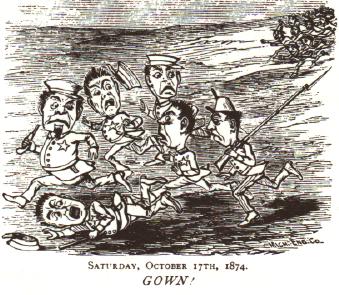|
As one can see, Ann Arbor was just beginning to see the challenges of becoming a diverse city. National issues of racial, ethnic and moral import were felt in Ann Arbor, while the community dealt with its own special needs. Tolerance of this new plurality, and the tension in the ethnic communities to avoid assimilation mingled with the city's search for a collective identity as the University began to define Ann Arbor. The landscape of the nation influenced Ann Arbor as well: industrial change, wars, slave emancipation and continuing immigration affected the moral identity of the United States. | ||||
|
| ||||
| ||||
|
A small community of Jews had begun growing in Ann Arbor and peaked in the years around 1850. The first Jewish settler, an unnamed gentleman noted only as a "tanner", arrived in 1843, and Marwil notes that the group's numbers may have reached one hundred (26-27). The Jewish community's members were active in local politics and economic affairs. The Weil family patriarch, Joseph, acted as rabbi in services held on West Washington Street (Marwil, 26). The discrimination that the Jewish community sometimes received was not apparently directed at their worship, but rather at their prosperity (especially in the case of the five Weil brothers' booming leather, fur and wool business). We know that Jacob Weil left in 1860, leaving his two-term role as alderman and taking his hard-earned wealth with him; he returned to New York (Marwil, 36.) At that time, there was also a need for tanners back in Detroit, and this loss of skilled craftsmen caused a decline in the presence of Jewish people for many years (Ryan, Early Ann Arbor and Its People). [The Wallenberg Legacy] It would be interesting to note the affiliation of this early community, whether they had to compromise Orthodox observance to live in rugged Ann Arbor - how would one acquire Kosher meat? - or if they were able to keep Sabbath rituals while doing business with a largely Gentile population. These difficulties were probably very real at that time for all American Jewish people: Isaac Mayer Wise, the forefather of Reform Judaism, had just arrived in America in 1846 (Marty, 287.) Unfortunately, sources are rather quiet about the Jewish residents of Ann Arbor. Stephenson's Ann Arbor: The First Hundred Years omits description of the Jewish community, as does Schepeler - Van der Werker's Earliest History of Ann Arbor. |

